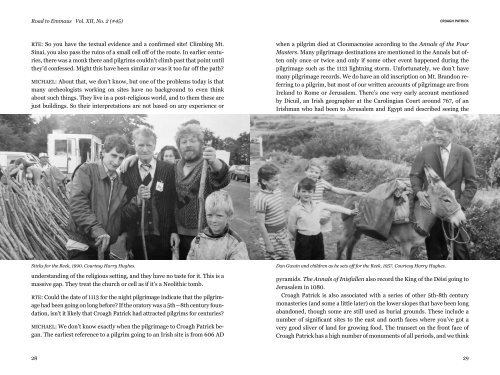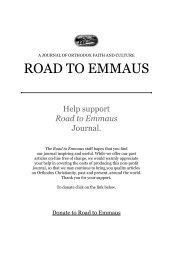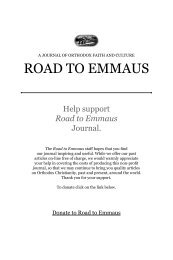RTE No 20 Interior - Road to Emmaus Journal
RTE No 20 Interior - Road to Emmaus Journal
RTE No 20 Interior - Road to Emmaus Journal
You also want an ePaper? Increase the reach of your titles
YUMPU automatically turns print PDFs into web optimized ePapers that Google loves.
<strong>Road</strong> <strong>to</strong> <strong>Emmaus</strong> Vol. XII, <strong>No</strong>. 2 (#45)CROAGH PATRICK<strong>RTE</strong>: So you have the textual evidence and a confirmed site! Climbing Mt.Sinai, you also pass the ruins of a small cell off of the route. In earlier centuries,there was a monk there and pilgrims couldn’t climb past that point untilthey’d confessed. Might this have been similar or was it <strong>to</strong>o far off the path?MICHAEL: About that, we don’t know, but one of the problems <strong>to</strong>day is thatmany archeologists working on sites have no background <strong>to</strong> even thinkabout such things. They live in a post-religious world, and <strong>to</strong> them these arejust buildings. So their interpretations are not based on any experience orwhen a pilgrim died at Clonmacnoise according <strong>to</strong> the Annals of the FourMasters. Many pilgrimage destinations are mentioned in the Annals but oftenonly once or twice and only if some other event happened during thepilgrimage such as the 1113 lightning s<strong>to</strong>rm. Unfortunately, we don’t havemany pilgrimage records. We do have an old inscription on Mt. Brandon referring<strong>to</strong> a pilgrim, but most of our written accounts of pilgrimage are fromIreland <strong>to</strong> Rome or Jerusalem. There’s one very early account mentionedby Dicuil, an Irish geographer at the Carolingian Court around 767, of anIrishman who had been <strong>to</strong> Jerusalem and Egypt and described seeing theSticks for the Reek, 1990. Courtesy Harry Hughes.understanding of the religious setting, and they have no taste for it. This is amassive gap. They treat the church or cell as if it’s a Neolithic <strong>to</strong>mb.<strong>RTE</strong>: Could the date of 1113 for the night pilgrimage indicate that the pilgrimagehad been going on long before? If the ora<strong>to</strong>ry was a 5th—8th century foundation,isn’t it likely that Croagh Patrick had attracted pilgrims for centuries?MICHAEL: We don’t know exactly when the pilgrimage <strong>to</strong> Croagh Patrick began.The earliest reference <strong>to</strong> a pilgrim going <strong>to</strong> an Irish site is from 606 ADDan Gwain and children as he sets off for the Reek, 1957. Courtesy Harry Hughes.pyramids. The Annals of Inisfallen also record the King of the Déisí going <strong>to</strong>Jerusalem in 1080.Croagh Patrick is also associated with a series of other 5th-8th centurymonasteries (and some a little later) on the lower slopes that have been longabandoned, though some are still used as burial grounds. These include anumber of significant sites <strong>to</strong> the east and north faces where you’ve got avery good sliver of land for growing food. The transect on the front face ofCroagh Patrick has a high number of monuments of all periods, and we think2829










